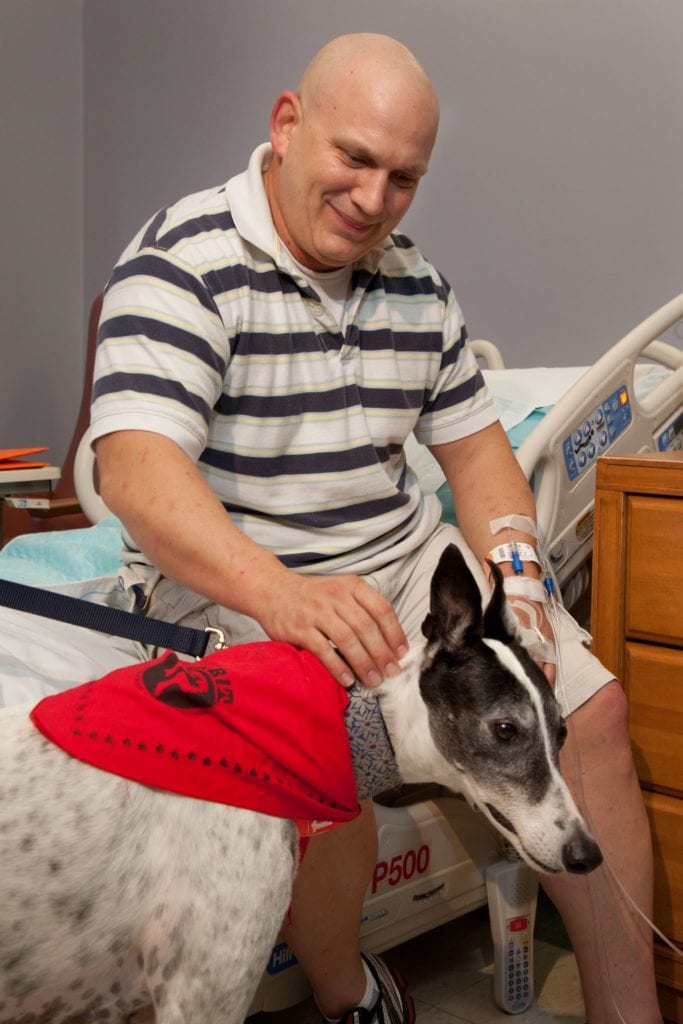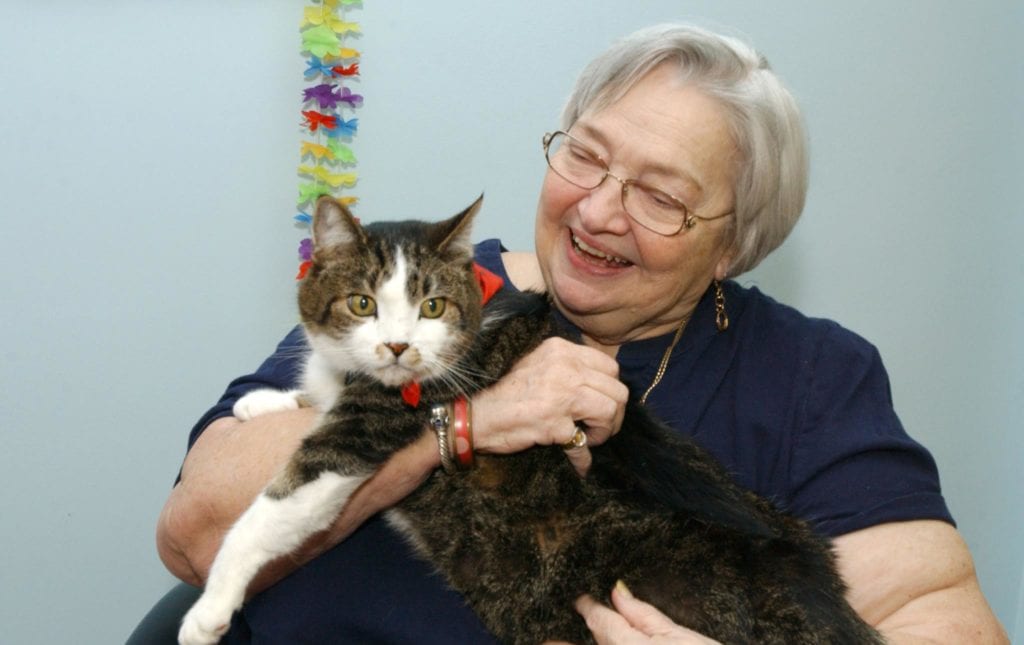The secret to a long and happy life
We’ve all heard stories about how pets can help us feel better and how they’re good for both our physical and emotional well-being. But these are more than just stories…they’re science. According to research, pet owners have less illness, recover faster from serious health conditions, and tend to be more content than people who do not own pets. Why is that? These studies have shown that dog walking, pet grooming, and even petting provide increased physical activity that strengthens the heart, improves blood circulation, and slows the loss of bone tissue. In addition, a pet can also increase its owner’s emotional health through activities that lead to social interaction, such as walks and park visits. Put simply, pets aren’t just good friends, they are good for our health.
Although much research has been done on the subject of companion pets and the elderly, this one is particularly compelling. A February 2018 article by the Harvard Medical School had this to say about canine companions for the elderly: “A canine companion provides unconditional love and encourages extra exercise. Could those benefits explain why dog owners are less likely to die of heart disease than people without dogs? Maybe, say the authors of the largest-ever study of dog ownership and human health. The 12-year study included over 3.4 million Swedish adults ages 40 to 80 and researchers found that dog owners had a lower risk of death due to heart disease. This benefit was especially evident in people who lived alone. Dogs may ease stress, loneliness, and depression and inspire people to be more active and socially connected — all things that seem to foster heart health.”
Karen Armsey is the Program Administrator at HABIT (Human Animal Bond in Tennessee), an outreach program associated with the University of Tennessee College of Veterinary Medicine that supplies medically and behaviorally screened dogs, cats and rabbits to over 200 facilities in East and Middle Tennessee. Established in 1986, HABIT sponsors programs that foster pet visitation to nursing homes, assisted-living residences, retirement centers, mental health centers, residences for children with special needs, rehabilitation facilities, and hospital settings.

Karen has been with HABIT for over twelve years and knows well the importance and benefits of animal-human bonds. “Physiologically, the presence of an animal, from fish to furry creature, lowers your stress level, lowers your blood pressure, and helps your pulse rate go down. This is due to the release of “feel good” hormones, including serotonin, prolactin and oxytocin. Psychologically, the benefit is that you have to take your pet out, get outside, meet and interact with people more. It’s hard to feel lonely and depressed if you’re engaging with people on a regular basis.”

While the challenges we face with the coming of old age are nothing new, they’ve been exacerbated by the fact that many Americans are living longer these days. Whether it’s from the death of a spouse or the isolation that comes from losing mobility, many elderlies find themselves living alone. “There is a way, however, for the elderly to find new meaning in their lives,” says Monica Brown of KnoxPAWS, “and that is by adopting a companion animal.”
KnoxPAWS (Placing Animals With Seniors) is a program associated with the Knoxville-Knox County CAC (Community Action Committee) Office on Aging–which helps eligible seniors partner with companion pets–and Monica is the program coordinator. Monica started working with, and adoring, animals from a very young age, working at shelters in Ohio and later in Florida. After decades of working with animals, she decided to do “something just a little bit different; work with people.” That meant going back to school, which she did, and after receiving her degree in Social Work she joined the team at KnoxPAWS. Working at KnowPAWS is her dream job, she says. “What I do here gives me my ‘animal fix’ and my ‘human fix’ and that is just perfect.”
“Studies show that having a pet can help reduce loneliness, depression, anxiety and stress, as well as increase activity and socialization for our seniors. I can tell you from my own experience that there is nothing more heart-warming than witnessing the transformation a senior makes when partnered with a companion pet.” What’s also incredibly amazing about what KnoxPAWS does for seniors is that they build ongoing relationships. “The relationship between KnoxPAWS and seniors doesn’t end with a pet placement,” says Monica. “Placement, in fact, is where the relationship begins.” It’s not uncommon for a senior to have frequent and regular contact with Monica. All of the seniors have her cell number and are encouraged to call her at any time. “I have a standing date, for instance, with one senior,” she says, “who is house bound. Every month, I pick her up and we take her pet to the vet together…and then we have lunch! We have connections, relationships with our pet parents, and that’s a very important piece of the service we provide.”
“There is nothing more heart-warming than witnessing the transformation a senior makes when partnered with a companion pet.”
—MONICA BROWN, KNOX PAWS
Another “side benefit” to what KnoxPAWS does relates to the shelters and their population of elderly animals. Many of the people who visit shelters in search of a pet are looking for those that are on the younger side, leaving the elderly animals to spend their lives in a shelter, or even worse, be put to sleep. By placing senior pets with senior pet parents, KnoxPAWS is helping those pets who might never find a loving home, to find one. And, since older animals are more likely to be calm, already housetrained, and less susceptible to unpredictable behavior, they make the perfect companion animals for seniors.
At the moment, KnoxPAWS serves just over 50 seniors in the Knoxville area. In Monica’s mind, this is just the tip of the iceberg. At one time, she says, the program was supporting in the neighborhood of 150 seniors. “This is such a wonderful program,” she says. “My hope is that more seniors will learn about it and participate. There are so many individuals, and pets, out there that can benefit.”
“We have 38 current participants and of those, five are partnered with cats, so our placements are predominantly dogs. Whenever we do a placement, the senior has a thought in mind of the kind of pet they want. What’s fun is that about 80% of the time, however, the pet they take home is not the pet they were planning on…they just fall in love, unexpectedly, and that’s just fun to watch!”
Take for example, Nadine Xander, a Knoxville senior who has just recently been partnered with Coco, a poodle of about 10 pounds and a senior himself. It all began when the poodle that Nadine had been living with for 15 years passed away. This was only about three months ago, and the loss hit Nadine very hard. After a couple of months on her own, she came to the realization that she was truly lonely. She decided that she’d look into finding another furry companion and that’s when she called Monica.
When Nadine and Monica were visiting shelters together in search of a pet, Nadine was hoping to find a poodle, like her previous companion. After visiting a few shelters and still in search of the kind of the pet she had in mind, Nadine met Coco. “It was completely by accident,” she says, “and I fell in love with him right away. It was fate, if you ask me.”
Nadine says that Coco had apparently been brought to the shelter by a dog catcher and looked like “he’d spent some hard times on the streets. Fortunately, his medications, grooming, vet visits…all are taken care of by KnoxPAWS. It’s absolutely remarkable!”
So, how has her life changed since Coco arrived? “Well,” says Nadine, “I’m guessing he’s 14 or 15 years old, but he still has lots of energy. It’s wonderful to have someone who keeps me going. I love taking him outside and going on walks with him. He’s absolutely adorable, so well behaved, so intelligent and loving. And, when we’re out walking he’s also quite the conversation piece! I couldn’t be happier.”

Comments are closed.